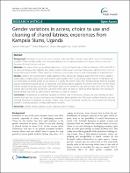| dc.description.abstract | Sanitation is one of the most intimate issues that affect women, especially in slums of developing
countries. There are few studies that have paid attention to the gender variations in access, choice to use and
cleaning of shared latrines in slums.
Methods: This paper draws on qualitative data from a cross sectional study conducted between 2012 and 2013 in
six slums of Kampala City, Uganda. The study involved both women and men. Data were collected from 12 Focus
Group Discussions (FGDs), 15 Key informant interviews; community transects and photographs of shared latrines.
Results: Location of a shared latrine facility, distance, filthy, narrow and irregular paths; the time when a facility is
visited (day or night), privacy and steep inclines were gender ‘filters’ to accessing shared latrines. A full latrine pit
was more likely to inhibit access to and choice of a facility for women than men. Results indicate that the available
coping mechanisms turned out to be gendered, with fewer options available for women than men. On the whole,
women sought for privacy, easy reach, self-respect and esteem, cleanliness and privacy than men. While men like
women also wanted clean facilities for use; they (men) were not keen on cleaning these facilities. The cleaning of
shared latrines was seen by both women and men as a role for women.
Conclusion: The presence of sanitation facilities as the first step in the access, choice, use, and cleaning by both
women and men has distinct motivations and limitations along gender lines. The study confirms that the use and
cleaning of latrines is regulated by gender in daily living. Using a latrine for women was much more than relieving
oneself: it involved security, intimacy and health concerns. | en_US |

